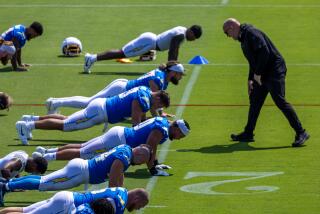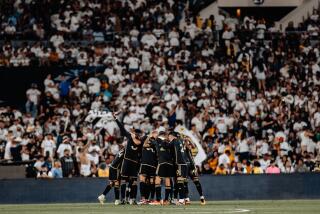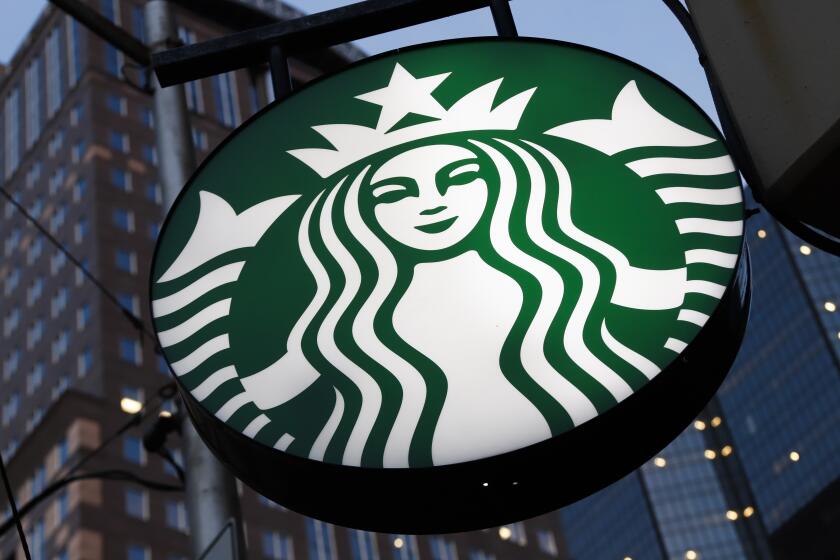L.A. officialsâ unseemly glorification of the NFL
There are several cardinal rules governing public works projects that smart municipal leaders have learned from grim experience. Here are the most important:
â¢Never name public edifices after politicians until theyâre dead and buried, and therefore safely beyond the reach of embarrassing indictments.
â¢Never let land developers think you need them more than they need you.
â¢Never, ever, kiss the National Football Leagueâs butt.
The best thing that could be said for the Los Angeles city officials who participated in a televised love-in Tuesday over a proposed downtown football stadium/âevent centerâ is that they violated only two of these three rules. The developer, AEG, has already cut a deal to sell naming rights to the building to Farmers Insurance, so unless Farmers gets indicted for fraud or sold to another company, its name can stay.
For the rest, however, itâs hard to remember another occasion when a Los Angeles mayor and leaders of the City Council slobbered so wetly and publicly over a private enterprise so far in advance of its actually delivering on a promise.
Itâs one thing to lionize AEG and its chief executive, Tim Leiweke. Theyâre responsible for building Staples Center and L.A. Live, which are commercial successes that unquestionably have sent positive ripples into the surrounding downtown.
Leiweke has proven himself to have a peerless grasp of how to make urban commercial developments work. More to the point, he has as good an understanding as anyone in L.A. of what hasnât worked. That includes the cityâs spavined convention marketing effort, an ancient shortcoming the new project is partially designed to rectify.
But what was unseemly about the appearances by Mayor Antonio Villaraigosa, City Council President Pro Tem Jan Perry (whose district includes the proposed stadium site) and council member Janice Hahn was their glorification of the NFL.
Letâs hold a quick history lesson. The NFL is a pro sports league that has never done the city of Los Angeles, the county of Los Angeles or Southern California any favors. Instead, the league and its owners have remorselessly manipulated municipalities region-wide, playing one against the other, and conniving to fleece the taxpayers.
Hereâs a short list of the local communities that were led to believe they had an NFL team in the bag or were serious contenders for a franchise, only to see their dreams turn into nightmares: Irwindale, Anaheim, Carson and the City of Industry. (Industry may yet think itâs in the running.)
Oh, and Los Angeles, Los Angeles and Los Angeles. Anybody remember the Coliseum? That was the NFLâs dream site for about a half a minute.
We shouldnât forget that Los Angeles lost not one but two NFL teams during the leagueâs brilliant strategic transition from big cities (Los Angeles metro population 17.8 million) to cosmopolitan garden spots such as Jacksonville, Fla.; Charlotte, N.C., and Nashville (combined metro populations: 3.55 million).
Ever since 1994, when the Rams and Raiders played their final home games in the Southland, the NFL has dangled the prospect of a franchise before starry-eyed local politicos. And the league still hasnât made a public commitment that the AEG project, even with the city administration foursquare behind it, will yield a team for L.A.
Villaraigosa, Perry and Hahn seem to think they have the upper hand, so theyâre insisting that not a dime of taxpayer funds can go into the proposed stadium. Unfortunately, they also made sure the NFL knows that much more is riding on the AEG proposal than bringing football back to town.
The proposed stadium is to be part of a revitalized convention center complex; the idea is for the facility to serve as a convention and exhibition site and event venue as well as a football stadium for nine home games a year.
The idea of building a multipurpose stadium/convention venue is resourceful, and it could well succeed. But by making the case that L.A. needs to build the stadium to upgrade its convention center â and of course it needs an NFL team to build the stadium â Villaraigosa, Perry and Hahn have given the NFL an enormous crowbar to prize concessions from them in return for that coveted team.
Do you really think this project will be built without any taxpayer contribution? Me neither. All thatâs really open for debate is how much the taxpayers will contribute, and where in the blueprints for the stadium and its appurtenant infrastructure that contribution will be hidden.
Tuesdayâs presentation, televised on the regional Fox Sports channel, set a new standard for a public-private partnership in self-interested boosterish flapdoodle. There were mockups of the stadium, video testimonials from business leaders and construction union members, with a passel of former greats from the NFL and the National Basketball Assn. in attendance.
There was even an endorsement of the project from Al Michaels, who Iâm sure was perfectly objective about it even though heâs the play-by-play man for NFL games on NBC. Michaels talked about how kind and good the NFL is about promoting all sorts of things people can do around a stadium âoutside the game.â I bet thatâs true, when the promotional fee is right.
But Michaels also gave away whatâs in this for AEG and the NFL, by observing there are âmillions and millionsâ of people in this metro area but there will be only 70,000 seats in the future Farmers Field. âThe demand is going to be extraordinary,â he crowed.
Farmers Field, if itâs built, might well be a useful adornment to the civic infrastructure, and its construction and operation would provide thousands of jobs. Can we trust our star-struck city administrators to cut the best deal with the developer and the league?
As Villaraigosa remarked in one of several encomiums to Leiweke at Tuesdayâs event, âHeâs not afraid to dream.â Iâm not afraid to dream, either. But this is the NFL weâre talking about, and Iâm terrified of nightmares.
Michael Hiltzikâs column appears Sundays and Wednesdays. Reach him at [email protected], read past columns at latimes.com/hiltzik, check out facebook.com/hiltzik and follow @latimeshiltzik on Twitter.
More to Read
Inside the business of entertainment
The Wide Shot brings you news, analysis and insights on everything from streaming wars to production â and what it all means for the future.
You may occasionally receive promotional content from the Los Angeles Times.











